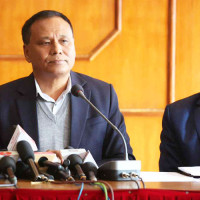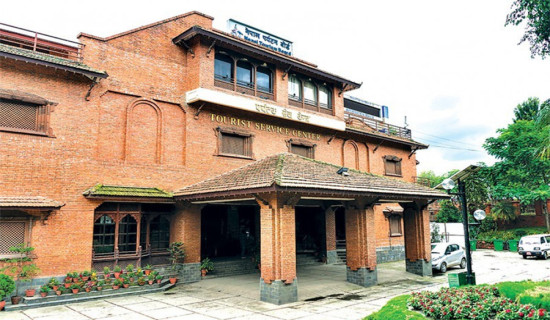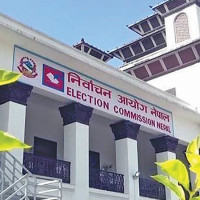- Wednesday, 24 December 2025
Nepal, India sign deal on cross-border transmission line expansion
Kathmandu, Apr. 23: Nepal and India have inked an important agreement to expand the cross-border transmission lines.
The landmark agreement for the development of two new 400 kV cross-border transmission lines—Dododhara (Lamki)-Barilly and Inaruwa-Purnea-- was signed in the presence of Minister for Energy, Water Resources and Irrigation Dipak Khadka and Minister of Power and Minister of Housing and Urban Affairs of the Government of India Manohar Lal Khattar in Kathmandu on Tuesday evening.
Director of Nepal Electricity Authority (NEA) Kamal Acharya and Director of Power Grid Corporation of India Limited Dr. Yatindra Dwivedi signed a Memorandum of Understanding for the development of the two cross-border transmission lines.
The agreement for the development of the energy sector was signed between the two countries in the presence of Indian Power Minister Khattar who arrived in Nepal on Tuesday for a two-day Nepal visit at the invitation of Energy Minister Khadka.
The 12th meeting of the Nepal-India Secretary-level Joint Steering Committee in New Delhi, India, on February 12, 2025, agreed to work on establishing a joint company to construct the 400 kV Inaruwa- Purnea and Dododhara-Bareilly transmission lines, and an agreement was signed to take the company forward.
According to the agreement, Nepal will own 51 per cent of the joint company to be established on Nepal side and India will own 51 per cent of the company to be established on the Indian side. The remaining 49 per cent will be held by another country.
About 25 kilometres of the Inaruwa- Purnea line will be in Nepal, and 100 kilometers in India, while 35 kilometers of the Dododhara-Bareilly transmission line will be in Nepal, and 150 kilometers in India.
On the signing ceremony, Minister Khadka said that the agreement was important in the energy development of the two countries.
“These projects are not just about electricity—they symbolise connectivity, trust, and shared progress. They bring our nations closer, not only through power trade but also through a common vision for sustainable growth,” said Minister Khadka.
He expressed gratitude for India’s continued support in large hydropower projects, such as Arun-3, Lower Arun, Arun-4, Phukot Karnali, Upper Karnali, SR-6 and West Seti.
These initiatives are vital to ensuring energy security and economic development, not just for Nepal, but for the region, he added.
He thanked India for the latter’s support in the energy development sector of Nepal.
He mentioned November 15, 2024, as a golden chapter in Nepal’s energy history as on that day, electricity was exported from Nepal to Bangladesh for the first time via the Indian transmission grid following
a tripartite agreement.
At the event, Indian Power Minister Khattar said that the progress made in the energy sector between the two countries was a testament to the deepening relationship between India and Nepal.
He said that the recent agreement for the development of the two transmission lines would strengthen the power ties between the two countries and would support to make realise the long-term power trade between Nepal and India.
Recalling the Joint Vision Statement issued between Nepal and India in 2022, he said that significant progress has been made in three main pillars - joint generation, cross-border infrastructure and electricity trade.
Minister Khattar expressed confidence that the new projects would further strengthen bilateral energy security with the start of construction of the Gorakhpur-Butwal transmission line. He said that the export of Nepali electricity to Bangladesh through the Indian transmission line was a historic achievement.
“The MoU signed between Nepal and India represents more than formal agreements. It symbolise our mutual trust, aligned priorities and the strategic aspiration of our two nations to lead the region towards a clean, connected and cooperative energy future,” said Suresh Acharya, Secretary at the Ministry of Energy, Water Resources and Irrigation.
Stating that hydropower produced in Nepal can be used as green energy in regional countries, he said that the agreement for the development of cross-border transmission line proved to be a milestone for this.
Energy Minister Khadka and Indian counterpart inspect Arun-3 projectMeantime, Minister for Energy, Water Resources and Irrigation Khadka and Minister for Power Khattar inspected the Arun III
Hydropower Project.
Khattar inspected the power house and dam area of the Arun III Hydropower Project under construction with Indian investment. During the visit, they jointly inaugurated ‘Unit-2’ of the project and planted trees near the power house.
During the inspection, the two ministers took information from the contractor company about the progress made in the project so far and the problems seen during the project construction.
Energy Minister Khadka thanked the Indian government for its support in the development of Nepal’s energy sector and directed the concerned bodies to complete the construction of the project on time.
“The government has given high priority to the Arun-3 Hydropower Project as it is the most important hydropower project in the country. The government will not allow any shortfall to accelerate the construction work of the project. You should work to complete the project as soon as possible,” he said.
Indian Power Minister Khattar said that Nepal has immense potential in the hydropower sector and prosperity could be achieved through the energy sector. He said that both countries should benefit from the early completion of the Arun-3 Hydropower Project and that it should be completed on time.
He said that the Indian government was ready to invest in Nepal’s hydropower sector. The Arun-3 Hydropower Project under construction on the border of Makalu Rural Municipality and Chichila Rural Municipalities of Sankhuwasabha has a capacity of 900 MW.
The foundation stone of the project was jointly laid by the then Prime Minister of Nepal KP Sharma Oli and Indian Prime Minister Narendra Modi in May 2018 with the aim of completing the project in five years.















-original-thumb.jpg)